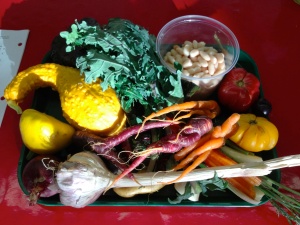
I love to feature the great initiatives on kids’ food education that are happening right here in my own backyard.
 Project CHEF (Cooking Healthy Edible Food) works with public schools in Vancouver to provide hands-on education to primary school children, with a one-week program for kids 8 to 10 years old, and a one-month “in-residence” program in which all children in a school (from 6 to 12 years old) get cooking classes. Project CHEF has provided food education to 6000 kids in the past 6 years! The brainchild of Barb Finley (a chef and former teacher) Project CHEF is supported by donations and grant funds. For more information about their amazing program, visit ProjectCHEF.ca.
Project CHEF (Cooking Healthy Edible Food) works with public schools in Vancouver to provide hands-on education to primary school children, with a one-week program for kids 8 to 10 years old, and a one-month “in-residence” program in which all children in a school (from 6 to 12 years old) get cooking classes. Project CHEF has provided food education to 6000 kids in the past 6 years! The brainchild of Barb Finley (a chef and former teacher) Project CHEF is supported by donations and grant funds. For more information about their amazing program, visit ProjectCHEF.ca.
 I recently had the pleasure of visiting a local classroom where Chef Barb was running one of her week-long ‘food education’ programs. What a treat! Barb and her team had transformed the classroom into an in-house cooking school, complete with a mascot (French chef! 😉 ).
I recently had the pleasure of visiting a local classroom where Chef Barb was running one of her week-long ‘food education’ programs. What a treat! Barb and her team had transformed the classroom into an in-house cooking school, complete with a mascot (French chef! 😉 ).
Kids were sitting at ‘team tables’, each with its own cooking zone (a hot plate), prep area (including knives for chopping, graters, and other useful utensils), and a vegetable tray full of the raw ingredients that the Grade 4 students—each divided into teams of 5 kids plus a volunteer parent helper—were going to transform into a delicious meal.
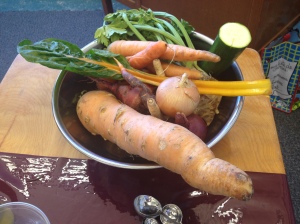 Minestrone was featured on the menu the day I visited. But not just any Minestrone. This soup featured fresh kale from the school garden, local herbs, and an amazing collection of vegetables from Farmer’s markets including Swiss chard. How is this going to go over, I wondered?
Minestrone was featured on the menu the day I visited. But not just any Minestrone. This soup featured fresh kale from the school garden, local herbs, and an amazing collection of vegetables from Farmer’s markets including Swiss chard. How is this going to go over, I wondered?
Barb started the class with a discussion of the recipe ingredients, asking students a series of questions that had them raising their hands eagerly. “How many vegetables are in this soup?” had everyone counting intently; the answers (ranging from 8 to 17) had everyone laughing, as Barb gently reminded kids how we define ‘vegetable’: an edible plant (or part of an edible plant) without seeds—usually, the stem, root, or leaf of a plant. (This explains why tomatoes and avocadoes are technically fruits!)
The kids were even more attentive when Barb began making the soup—chopping the onion, then the other ingredients at her demo table—including some monstrous looking carrots that had the kids gasping and laughing in appreciation.
“What’s this one doing? The tango?” Barb asked, waving a gnarly, three-headed carrot at the class, followed by: “We like vegetables with character, like this one. They have more flavor!” While Barb proceeded to chop and sample the ‘tango carrot’ (“A good cook tastes her veggies!”), the class was utterly attentive: you could have heard a pin drop.
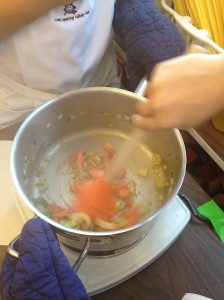 When she slid the chopped onions into the olive oil, which sizzled away, the class reaction took even me by surprise. “That’s SO cool!” shouted one boy. “It smells SO good!” said a girl at my table.
When she slid the chopped onions into the olive oil, which sizzled away, the class reaction took even me by surprise. “That’s SO cool!” shouted one boy. “It smells SO good!” said a girl at my table.
As Barb worked her way through the recipe, guided by the kids, they learned about everything from ‘measurement versus estimation’, to the secret of cooking onions successfully. You could sense they were eager to act on Barb’s tips. “How do I cut this sage up?” she asked? “With my hands—a cook’s best instrument!” Handing the sage to a couple of children, she encouraged them: “Now smell your hands!” Thirty pairs of hands reached for the sage leaves on each table, and I noticed the parent volunteers doing the same.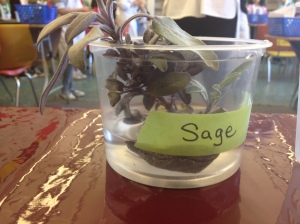
As the delicious smell of Barb’s simmering demo soup filled the room, the ‘table teams’ started to make their own soups. This went much more smoothly than I expected, as each child had an assigned role (which changed every day throughout the week-long cooking class): Task, Supply, Washer, Drier and Station “Meisters.” Just like a ‘line chef’ in a restaurant, each child had their responsibilities-a great way to avoid fights over who does what, and encourage cooperation.
I admit that the chopping part of the class had me a bit worried. Thirty 8 year olds wielding sharp knives? But I was reassured, as they had been trained by Barb and her team in “The Claw”: a safe knife-handling technique. Sure enough, the kids folded their fingers back and hid their thumbs in a “claw” that safely held the veggies, while chopping everything from onions to garlic, carrots to tomatoes. Impressive!
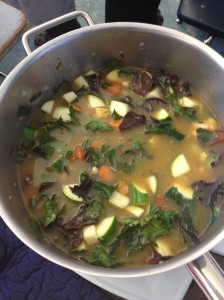 Soon, seven soups were simmering away, while the kids sat down to fill out worksheets. Barb took a few minutes to explain to me some of the secrets of success of her cooking program. First, kids make a commitment on the first day: “open mind, open mouth!” They promise to try everything, and the week-long menu is designed to have them tasting new things every day. Peer pressure, and the thrill of preparing foods themselves, really helped—Barb explained—in encouraging them to try new foods. She showed me the various lesson plans she had developed—all fully integrated with our provincial curriculum. Interest has been so strong that Barb’s classes now run 5 days a week, 9 months of the year. In some schools, her team will set up for a month, training the entire primary school in age-appropriate cooking skills. When Project CHEF leaves the school, teachers have new ideas about ways to incorporate food and cooking into subjects ranging from English and Science to Art and Geography.
Soon, seven soups were simmering away, while the kids sat down to fill out worksheets. Barb took a few minutes to explain to me some of the secrets of success of her cooking program. First, kids make a commitment on the first day: “open mind, open mouth!” They promise to try everything, and the week-long menu is designed to have them tasting new things every day. Peer pressure, and the thrill of preparing foods themselves, really helped—Barb explained—in encouraging them to try new foods. She showed me the various lesson plans she had developed—all fully integrated with our provincial curriculum. Interest has been so strong that Barb’s classes now run 5 days a week, 9 months of the year. In some schools, her team will set up for a month, training the entire primary school in age-appropriate cooking skills. When Project CHEF leaves the school, teachers have new ideas about ways to incorporate food and cooking into subjects ranging from English and Science to Art and Geography.
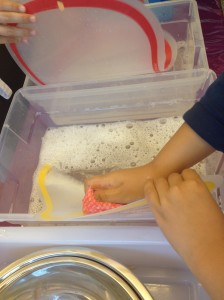 While we chatted, the children washed, dried, and stored their cooking implements (ready for use by the next class), and then set down to work on their “learning logs”, which they use to write reflections and connect the new learning to their lives. When they were finished, they began setting the tables with real china bowls and cutlery. Time to serve the soup! As it was lunchtime, everyone was feeling a little hungry. Meanwhile, curious faces peeked in at the door: other kids heading outside to play for lunchtime recess. You could tell by the looks on their faces they would have liked to join us!
While we chatted, the children washed, dried, and stored their cooking implements (ready for use by the next class), and then set down to work on their “learning logs”, which they use to write reflections and connect the new learning to their lives. When they were finished, they began setting the tables with real china bowls and cutlery. Time to serve the soup! As it was lunchtime, everyone was feeling a little hungry. Meanwhile, curious faces peeked in at the door: other kids heading outside to play for lunchtime recess. You could tell by the looks on their faces they would have liked to join us!
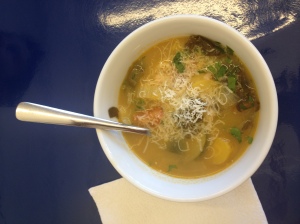 I sat down at a table with my own bowl, and watched the kids around me. Many kids, Barb explained, didn’t sit down and eat with their families. North American surveys suggest that 70% of families don’t eat together on a regular basis. Kids eat at the computer, in front of the TV, or in their bedroom. Eating together, she emphasized, was one of the best ways to ensure kids accepted—and liked—healthy food. That seemed to be the case at my table. Three of the kids polished off their bowls and asked for more. Even the more hesitant eaters ate at least half their bowls. No one refused it outright. Looking around the room, this seemed to be pretty representative. Success!
I sat down at a table with my own bowl, and watched the kids around me. Many kids, Barb explained, didn’t sit down and eat with their families. North American surveys suggest that 70% of families don’t eat together on a regular basis. Kids eat at the computer, in front of the TV, or in their bedroom. Eating together, she emphasized, was one of the best ways to ensure kids accepted—and liked—healthy food. That seemed to be the case at my table. Three of the kids polished off their bowls and asked for more. Even the more hesitant eaters ate at least half their bowls. No one refused it outright. Looking around the room, this seemed to be pretty representative. Success!
Cleanup was fast: the kids filed up, and scraped leftovers into the compost bucket (which they would later bring out to the school compost heap, next to the garden). Bowls were neatly piled, cutlery dunked in the soapy water in big buckets, and everyone headed out to play.
Barb and her team had 30 minutes to clean and dry the dishes and prepare the room for the next class, after lunch. Imagine doing this 5 days a week, 9 months of the year, while writing grant proposals and fundraising in the evenings and on weekends. Like many local ‘food education’ organizations, Project CHEF exists because of the devotion of a small team of dedicated people. But as Barb’s team showed, it only takes a few to make a huge difference!
Thank you, Project CHEF, for all of the great work you do!



Pingback: Fall Program Update | Project Chef Fall Program Update | blog
Hi Karen,
Thanks so much for the wonderful article. It was great to meet you and we hope you can come and cook with us again soon!
LikeLike